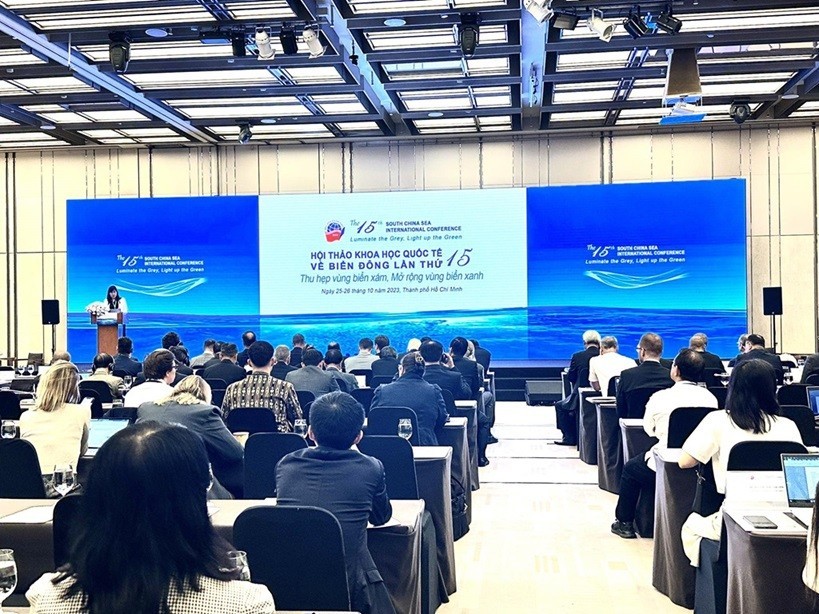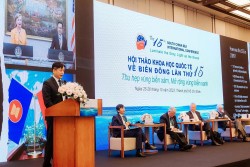
Grey Zones and Blue Seas in the East Sea - Good to Know (Part 1)
Latest
 |
| The 15th South China Sea International Conference (October 25-26, 2023) has set out the criteria "Luminate the grey, Light up the green". (Photo: DN) |
"Luminate the grey" aims to make the maritime zones more transparent and peaceful, and "Light up the green" aims to identify the potential of the sea in the future, by promoting good practices in important fields such as green transformation, green technologies, research and investment on wind energy, recycled energy …
Gray zone operations
"Gray Zone" is a symbolic concept, with no clear definition. Western scholars use the term “Gray zone operations”. China's leaders have never used the term “Gray zone operations” but rather outlined the doctrine of "Three warfares," including legal warfare. “Gray zone operations” or “Gray zone tactics” exploited by states and non-state entities have the purpose of using or creating ambiguity of the law to strengthen their positions, downplay opponents' positions in disputes in order to achieve their political, military, economic ends but not exceeding the threshold of war or armed conflict.
In practice, gray zone operations overlap with so-called legal warfare (lawfare) as “the strategy of using or misusing law as a substitute for traditional military means to achieve an operational objective" or the use of "double standards." They challenge international law, especially the Law of Armed Conflict.
However, the concept of “Gray zone operations” is broader than "legal warfare" as it uses both legal and non-legal tools and tactics, in conjunction with the law, to advance strategic objectives.
Moreover, while the law governs both lawful and unlawful conduct, not all “Gray zone operations” are unlawful, especially in an asymmetric war and the existence of ambiguity and inconsistency in the interpretation and application of international law. Gray area operations are more diverse when they can include information operations and disinformation, political coercion, economic coercion, pressure on individual leadership decisions or choices, cyber operations, space operations, which entail efforts to disrupt the normal space activities of competitors, support military and paramilitary forces of another party to perform proxy missions, provocation to lead enemy armed and paramilitary forces of taking disadvantage decisions or a combination of different forms. Gray zone operations have coercive and gradualist characters accumulating and probing the opponent's tolerance threshold before escalating to the next level. Therefore, gray zone tactics are also known as cabbage tactics or salamislicing tactics.
In the East Sea, gray zone operations in China's relations with neighboring countries usually manifest itself in the 4 forms as follows: Deliberately misusing and misinterpreting the terms and concepts of UNCLOS or applying "double standards"; Exploiting uncertainties or leaks in the law of armed conflict as in the case of maritime militia use.; Enacting and enforcing domestic laws inconsistent with international law;
To deal with gray zone tactics, States need to manage and dismantle regulatory ambiguity when negotiating, applying, and even using juridical agencies for proper interpretations. States need to cooperate, exchange experiences, expose gray zone operations that violate international law, and jointly condemn and create public opinion to prevent them.
3P formula
Since 2009, author Nguyen Hong Thao has proposed the 3P formula including Public Opinion, Publicity and Public International Law to deal with gray zone tactics and legal warfare. "Public opinion" is based on the strength of domestic and international public opinion. To mobilize the power of public opinion and reduce ambiguity, the element of "Publicity" is needed to promote propaganda and disseminate information to the masses of people about legal bases and historical evidence affirming Vietnam and other’s legitimate rights and interests in the East Sea.
| More from WVR |
 For a greener and more transparent East Sea For a greener and more transparent East Sea |
At the same time, it is to publicize unlawful activities to the international community to know and voice together their opposition. "Public International law", is the foundation for the struggle to eliminate the grey zone operations, increasing the support of domestic and foreign public opinion on the righteousness of the stances in accordance with international law. Vietnam needs to strengthen propaganda and training to raise awareness of international law and build the capacity of maritime management forces (such as Coast Guard and Fishery Inspectors) to effectively exercise Vietnam's legitimate management rights at sea.









